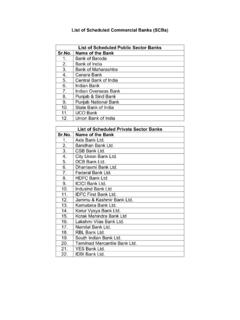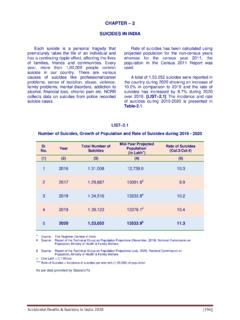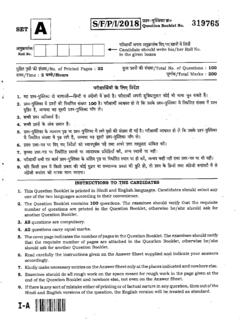Transcription of Monthly, Seasonal and Annual Rainfall Time Series for All ...
1 ISSN 0252-1075 Contribution from IITM Research Report No. RR-138 ESSO/IITM/STCVP/SR/02(2017)/189 Monthly, Seasonal and Annual Rainfall Time Series for All-India, Homogeneous Regions and Meteorological Subdivisions: 1871-2016 All-India summer monsoon (JJAS) Rainfall : 1871-2016 Kothawale and M. Rajeevan Indian Institute of Tropical Meteorology (IITM) Earth System Science Organization (ESSO) Ministry of Earth Sciences (MoES) PUNE, INDIA ISSN 0252-1075 Contribution from IITM Research Report No. RR-138 ESSO/IITM/STCVP/SR/02(2017)/189 Monthly, Seasonal and Annual Rainfall Time Series for All-India, Homogeneous Regions and Meteorological Subdivisions: 1871-2016 Kothawale1 and M. Rajeevan2 1 Indian Institute of Tropical Meteorology, Pune-411008 2 Ministry of Earth Sciences, Govt. of India, New Delhi-110003 *Corresponding Author Address: Dr. Kothawale Indian Institute of Tropical Meteorology, Dr. Homi Bhabha Road, Pashan, Pune 411 008, INDIA E-mail: Phone: +91-20-25904532 Indian Institute of Tropical Meteorology (IITM) Earth System Science Organization (ESSO) Ministry of Earth Sciences (MoES) PUNE, INDIA DOCUMENT CONTROL SHEET ---------------------------------------- ---------------------------------------- ---------------------------------------- -------------- Earth System Science Organization (ESSO) Ministry of Earth Sciences (MoES) Indian Institute of Tropical Meteorology (IITM) ESSO Document Number ESSO/IITM/STCVP/SR/02(2017)/189 Title of the Report Monthly, Seasonal and Annual Rainfall time Series for All-India, Homogeneous Regions and Meteorological Subdivisions: 1871-2016 Authors Kothawale, M.
2 Rajeevan Type of Document Scientific Report (Research Report) Number of pages and figures 169, 40 Number of references 16 Keywords Southwest monsoon, significant trend, excess monsoon years, deficit monsoon years Security classification Open Distribution Unrestricted Date of Publication August, 2017 Abstract In this scientific research report, monthly, Seasonal and Annual area weighted Rainfall time Series for all-India, 5 homogeneous regions and 30 meteorological subdivisions for the period 1871-2016 are constructed on the basis of a fixed and well distributed network of 306 rain gauge stations over India. Summer monsoon Rainfall percentage departure Series for all-India, homogeneous regions and all the subdivisions have been plotted indicating the excess, deficit and normal monsoon years. The statistical characteristics of the Series Mean, Standard Deviation, Trend for different periods (1871-2016: Entire period and 1981-2016 : Recent period) are also shown in the diagrams.
3 Summary All-India monsoon Rainfall shows very weak decreasing trend of mm and mm per year for the period 1871-2016 and 1981-2016 respectively. During the recent period 1981-2016, on the sub-divisional scale, East Rajasthan and Saurashtra, Kutch & Diu show significant increasing trend in monsoon Rainfall at 10% and 5% significance level respectively. Whereas, there are 3 subdivisions namely East uttar pradesh , Assam and Meghalaya and Sub-Himalayan West Bengal which show significant decreasing trend at 1%, 10 % and 10 % significance level respectively. The recent period mean Seasonal Rainfall of India as whole is decreased by mm from the mean Seasonal Rainfall based on the period 1871-1980. However, change in mean Rainfall is not statistically significant. While, mean Seasonal Rainfall of Central Northeast India and Northeast India for the recent period is significantly reduced from the period 1871-1980. On the sub-divisional scale, the mean Seasonal Rainfall based on the period 1981-2016 is significantly reduced from mean Seasonal Rainfall for the period 1871-1980 over the 7 subdivisions 1) Assam & Meghalaya, 2) Nagaland, Mani.
4 , Mizoram &Tripura, 3) East uttar pradesh , 4) West uttar pradesh , 5) East Madhya pradesh , 6) Chhattisgarh and 7) Kerala and increased over 2 subdivisions 1) Konkan & Goa and 2) Coastal Andhra pradesh . The information of regional and sub-divisional Rainfall is very much useful to the Researchers, Policy makers and Governmental agencies. This report is updated version of earlier IITM Research Report (Parthasarthy et al. 1995). Contents 1. Introduction 1 2. Details of Rainfall Data and Methodology 2 3. Quality Control of the Data 3 4. Preparation of All-India, Homogeneous Regions and 4 Subdivisional Rainfall Series 5. Statistical Characteristics of All-India, 5 Homogeneous Regions and Subdivisional Rainfall Series 6. Summary 8 Acknowledgements 9 References 9 Figure Captions 10 Table Captions 13 Figures 16 Tables 56 1 1 Introduction The variability of the Indian summer monsoon (ISM) affects the agriculture food grain production, industry and generation of hydroelectric power, causing severe strain on the national economy.
5 Large parts of the country are severely affected due to deficit monsoon Rainfall and government of India spends large amount of money on providing relief in affected areas. Importance of ISM to Indian economy and as major global circulation parameter has motivated many scientists to study the variability of Indian monsoon, in the past. During the last 4 to 5 decades, the Rainfall Series have been tabulated and the interannual variability of monsoon Rainfall has been rigorously examined by several researchers, notably by Parthasarathy and Dhar (1976), Parthasarathy and Mooley (1978), Alvi and Koteswarm (1998), Thapliyal and Kulshresta (1991), Srivastava et al. (1992). These Series were prepared with the number of rain gauge stations varying from 300 to 3,000 spread all over India for the different length of period starting from 1841 onwards. Recently Guhathakurtha and Rajeevan (2008) constructed monthly, Seasonal and Annual Rainfall time Series of 36 meteorological subdivisions of India (Figure 1) and India as one unit using the monthly Rainfall data for the period 1901-2003 with fixed network of 1476 rain gauge stations and later updated by Gughathakurta et al.
6 (2015). They found a very good agreement between all-India summer monsoon Rainfall Series constructed by them and IITM Rainfall data Series . The correlation between these two Series is Parthasarathy et al. (1995) have prepared monthly, Seasonal and Annual Rainfall time Series for all-India, 29 meteorological subdivisions and 5 homogeneous regions on the basis of fixed 306 rain gauge stations for the period 1871-1990. These Rainfall Series were updated time to time up to the 2014. However, the Rainfall time Series for the period 1991 to 2014 were not based on fixed network of 306 stations due to insufficient availability of station Rainfall data. Hence, Rainfall Series for the period 1991 to the latest available period (2014) were constructed by using sub-divisional Rainfall data obtained from India Meteorological Department (IMD) by applying method given by Parthasarathy et al. (1992b) to maintain the consistency with Rainfall Series based on the station data.
7 In the present Research Report, maximum efforts have been made to update the monthly Rainfall data of 306 stations for the period 1991 to the recent available (up to 2014) and all-India, homogeneous regions and sub-divisional Rainfall Series were constructed for the same period. However, due to insufficient availability of stations data 2 for the period 2014-2016 the Rainfall Series of all-India, homogeneous regions and few subdivisions were constructed from IMD sub-divisional Rainfall , as mentioned above. 2 Details of Rainfall data and Methodology The validity of any statistical analysis depends on the quality of the data network of the stations used in the analysis. The number of rain gauge stations in the country has increased from about 50 in 1850 to 5,000 in 1990 (Parthasarthy et al. 1995). To avoid inhomogeneity, the initial screening of all the available data sets have been made and 306 rain gauge stations, one from each of the districts in the plain regions of India and distributed fairly uniform over the country, were selected to form the network of rain gauge stations in this report.
8 A care has been taken to exclude a non-homogeneous record and only reliable or corrected stations data have been used to construct area averaged Rainfall Series . The earliest year for which reliable data are available for these stations is 1871. The relevant monthly Rainfall data of 306 stations have been obtained for the period 1871 to the present from the records of IMD, Pune. The hilly regions consisting of four subdivisions in Himalayas (hatched areas in Figure 2, subdivision number 2, 12, 15 and 16) have not been considered in view of the inadequate rain gauge network and low areal representation of a rain gauge in a hilly area; moreover these regions receive substantial Rainfall in the other seasons than the monsoon season. The island in the Bay of Bengal (subdivision number 1) and the Arabian sea ( subdivision number 36) have also not been considered for the present study to maintain contiguity.
9 The contiguous area considered measures Sq. Km. which constitutes about 90% of the country s total area. The spatial pattern of mean summer monsoon Rainfall map based on data for 306 stations over the period 1871-1978 ( Parthasarathy 1984a) is in good agreement with climatological (normal) map prepared by the India Meteorological Department (IMD) on the basis of about 3,000 rain gauge stations for the period 1901-50 (Rao, 1976, IMD, 1981). This shows that the Rainfall stations selected in this study are adequately representative. The main source of monthly Rainfall data of the 306 stations is National Data Center, IMD Pune. However, Rainfall data of some of the 306 stations were not readily available in the published form or in the form of soft copy with IMD Pune. Hence, attempts were made to fill up the missing Rainfall values from the different data sources i. e. Irrigation Dept., Revenue Dept., Agriculture Department of State Government, Regional Meteorological Centre of respective stations, Indian Daily Weather Reports 3 (IDWR) and Monthly Climatic Data for the World.
10 The quality and homogeneity of the obtained data were examined critically. After filling the missing Rainfall values, 93 to 97% of the 306 stations Rainfall data are available for the period 1991-2014 except the 2014, where 75% of the 306 stations data are available. On the sub-divisional scale, 90 to 100% stations Rainfall data out of total number of stations in those sub-division are available for the period 1991-2014. However, for very few subdivisions, 70 to 80 % stations Rainfall data are available for the year 2013 and 2014. Lastly, remaining missing monthly Rainfall values were estimated by the technique mentioned by Parthasarthy et al. (1992b). The technique is as follow. Where, RSTN(i, j) = Station Rainfall , RSD(i, j) = Sub-divisional Rainfall , RSTN(J) = Station mean Rainfall , RSD(j) = Subdivisional mean Rainfall , i is the year & j is the month. 3 Quality control of the data Quality control measures were also taken up to identify outliers/errors in data archival process, such as keying or printing mistakes.







